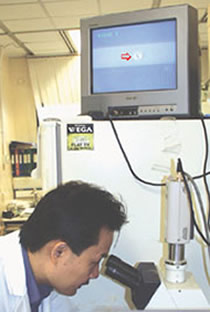.gif)
|
“One problem is that good as well as bad cells are killed.” The method succeeds by and large because cancer cells grow faster and so get killed at a faster rate than the normal cells, he said. The new approach Dr Liang is working on is at the forefront of worldwide research which has been trying to inhibit the proteins that drive cancer cells in their uncontrolled reproduction. To do this, he first looked for the proteins in budding yeast which contains genes that are also found in humans for the fundamental cellular processes. “Genes are composed of DNA and contain instructions for the production of proteins which make up the structure of cells and direct their activities,” Dr Liang explained. “More than 70 percent of yeast genes have counterparts in human cells.” He has invented a very sensitive genetic screen, or biological sieve, and used it to identify several novel proteins that initiate the reproduction of DNA. A complication however is that, many of these proteins are also involved in other biological processes. Yeast has about 6,000 genes, 1,300 of which serve essential biological functions, said Dr Liang. Of this number, the functions of 200 were previously unknown. Scientists are trying to study these genes and, during the last two years, Dr Liang and his researchers have tested about 100 of them for their potential role in DNA replication. “So far we have identified at least five suspects, and one is confirmed,” said Dr Liang. The next step is to study the functions of similar genes in humans and how they can be used to diagnose cancer and used in the development of drugs to cure cancer.” Dr Liang added: “Studies by us and others show that cancer cells need to replicate DNA just like yeast and they use the same kind of proteins to replicate. But more than 90 percent of the cells in our bodies don’t need to proliferate so we don’t need the proteins for DNA replication. “Proliferation is how we differentiate cancerous from non-cancerous cells. So, if proteins for initiating DNA replication are present, it will indicate cancer.” The method, says Dr Liang, is very sensitive. “Using it, we could detect cancer very early, before any modern-day clinical methods, even when there are no physical signs of cancer; that means at the pre-cancer stage. By the same principle, if we block the production or function of these proteins, cancer cells will not proliferate, and they will even die, as we have found.” He added: “This is a breakthrough but we’re still at the beginning of research.” “Most of the proteins that cause cancer when they are mutated are regulators. They are out of control and tell the cells to go, go, go,” said Dr Liang. “So, if you attack the protein, the cancer may not grow. One potential problem is that there are many signals involved in cell proliferation. Blocking one may not stop the process. What we’re doing is blocking the engine, the duplication of the genome, so that proliferation doesn’t take place even when a wrong signal is given to the cells.” Principal Investigator Dr Chun Liang : bccliang@ust.hk |
||||||||||||||||||||||
